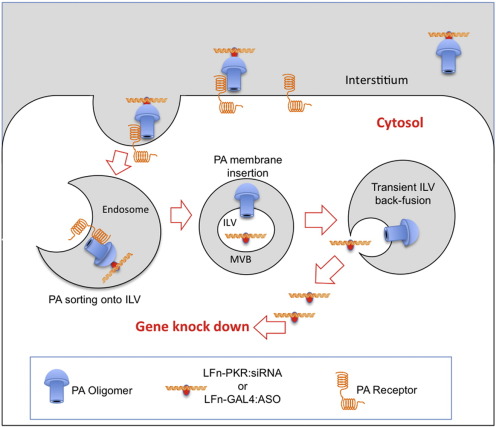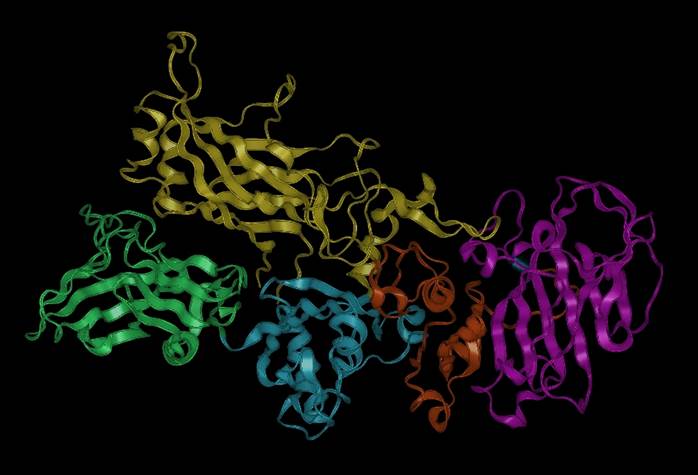During the development of this technology, scientists used the LOQ instrument at ISIS to characterise the system they’d built and see that the drug delivery molecules they had designed were behaving as predicted.
This novel approach towards treating disease, including cancer, could also have anti-viral and food security applications.
The team led by Dr Simon Richardson at the University of Greenwich showed that by disarming the ‘warhead’ within anthrax, the toxin can be converted into a positive tool for delivering ‘heavy’ drugs, or those with a large mass, to where they are most needed within the cell.
To test the delivery system, experiments were done on cancerous human cells (both HeLa (cervical cancer) and THP-1 (leukemia) cells) that were grown in the laboratory at the University of Greenwich.
Scientists were able to deliver these drugs to their end destination with high efficiency and low toxicity, showing that their proposed method is effective thus far.
“This is the first time a disarmed toxin has been used to deliver gene-modulating drugs directly to a specific compartment within the cell. We've achieved this without the use of so called helper molecules, such as large positively charged molecules like poly(L-lysine). This is important as while these positively charged molecules, known as polycations, can condense DNA and protect it from attack by enzymes before it reaches the target, they are also known to be toxic, break cell membranes and are sent quickly to the liver to be removed from the body. In this study we demonstrate that using disarmed toxins without a polycation is effective, at a cellular level," said Dr Simon Richardson, team leader from the University of Greenwich.

Exploiting membrane back-fusion for the delivery of ASOs and siRNA. This cartoon is adapted from data describing the cytosolic translocation of LF(n). For the purposes of this study it is used to illustrate the possible route taken to the cytosol by the Atx derived delivery systems described herein i.e. PA:LFn-GAL4:ASO or PA:LFn-PKR:siRNA. Image: care of University of Greenwich
View full-size image
This new breakthrough builds upon years of research that has shown that synthetic, man-made materials (that have many well-known limitations) are not the only tools that can be used to deliver gene therapy drugs. The gene therapy drug that this technology has been developed in relation to is known as antisense (or siRNA) therapy, which effectively turns off the expression of a gene causing problems.
The research has been published in the Journal of Controlled Release.
Anthrax is an acute disease caused by a bacterium that spreads via spores, which can become fatal when activated. Its ability to spread through the body so ‘effectively’ makes it attractive to scientists as a potential tool for drug delivery. By exploiting anthrax toxin’s natural ability to navigate cells’ defences, the toxin components can be used to access specific compartments within a cell.
In the toxin, the protective antigen (PA) pore, or ‘gate keeper’, inserts itself in the membrane of the host’s cell. It then interacts with warhead-carrying proteins, one of which is known as lethal factor, and facilitates the translocation of the warhead to the inside of the cell, or cytosol, so it can see its target.
Using genetic engineering, scientists removed the warhead from lethal factor but left the rocket motor intact for transportation into the cytosol. Scientists then replaced the warhead with a DNA or RNA binding protein which was bound to the antisense DNA, and demonstrated they could transport the drug over the PA pore.

Anthrax toxin is composed of a cell-binding protein, known as protective antigen. This ribbon diagram shows the structure of the PA83 monomer.
View full-size image
Dr Paul Dyer, University of Greenwich used ISIS instrument, LOQ to characterise the system they’d built:
"Understanding the nature of toxin pore biology, in particular how proteins transit through the pore, provides insights into novel drug delivery strategies and therapeutics to prevent Anthrax intoxication in animal and humans. We are currently using neutron reflectometry and scattering to evaluate this process in nanodiscs containing the anthrax pore.”
Now that the team have demonstrated that anthrax can be used to deliver the gene therapy drug to the target cell, their focus turns to trying to find out exactly how the drug gets into the cell and if this system can be used in a more complex environment that is more like a patient than cells growing in a dish.
Dr Paul Dyer will return to ISIS to lead further neutron experiments. During this time he hopes to see how the PA pore opens the gate for the drug to pass through into the cell.
Results from this project may not only impact on the use of gene therapies in the fight against cancer, but may also apply to food security and preventing the release of anthrax both accidentally and deliberately.
Dr John Webster, Group Leader of the Large Scale Structures Group at the ISIS Neutron and Muon Source believes that “Neutron Scattering and Muon Spectroscopy can provide a unique window into the way complex molecules organise themselves. The results here are a good example of where this capability is especially useful when it comes to probing the mechanisms of biological transport such as drug delivery. We look forward to seeing how this work unfolds in the future.”
Emily Mobley
Research date: December 2015
Further Information
The results were published in the printed edition of Journal of Controlled Release on December 28th as an open access paper which can be found by following this link: http://www.sciencedirect.com/science/article/pii/S0168365915302200. The paper has also been reported in the Atlas of Science: http://atlasofscience.org/using-anthrax-toxin/.
Dr Richardson and Dr Dyer both own shares in Intracellular Delivery Solutions (IDS) Ltd., a company set up to further develop this technology. Dr Richardson also serves as CSO at IDS Ltd.
